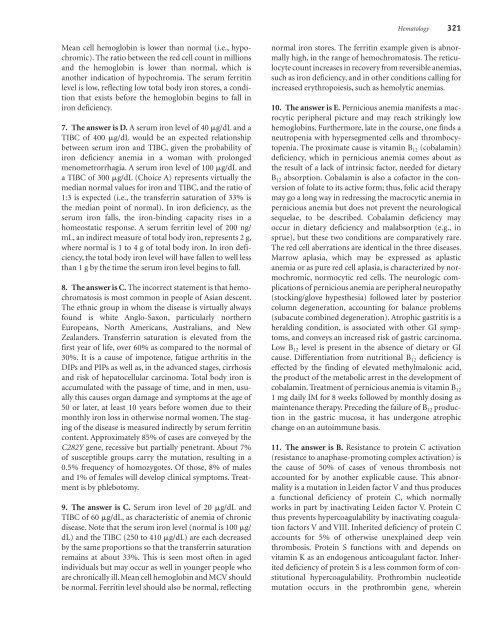NMS Q&A Family Medicine
NMS Q&A Family Medicine
NMS Q&A Family Medicine
- No tags were found...
Create successful ePaper yourself
Turn your PDF publications into a flip-book with our unique Google optimized e-Paper software.
Hematology 321Mean cell hemoglobin is lower than normal (i.e., hypochromic).The ratio between the red cell count in millionsand the hemoglobin is lower than normal, which isanother indication of hypochromia. The serum ferritinlevel is low, reflecting low total body iron stores, a conditionthat exists before the hemoglobin begins to fall iniron deficiency.7. The answer is D. A serum iron level of 40 g/dL and aTIBC of 400 g/dL would be an expected relationshipbetween serum iron and TIBC, given the probability ofiron deficiency anemia in a woman with prolongedmenometrorrhagia. A serum iron level of 100 g/dL anda TIBC of 300 g/dL (Choice A) represents virtually themedian normal values for iron and TIBC, and the ratio of1:3 is expected (i.e., the transferrin saturation of 33% isthe median point of normal). In iron deficiency, as theserum iron falls, the iron-binding capacity rises in ahomeostatic response. A serum ferritin level of 200 ng/mL, an indirect measure of total body iron, represents 2 g,where normal is 1 to 4 g of total body iron. In iron deficiency,the total body iron level will have fallen to well lessthan 1 g by the time the serum iron level begins to fall.8. The answer is C. The incorrect statement is that hemochromatosisis most common in people of Asian descent.The ethnic group in whom the disease is virtually alwaysfound is white Anglo-Saxon, particularly northernEuropeans, North Americans, Australians, and NewZealanders. Transferrin saturation is elevated from thefirst year of life, over 60% as compared to the normal of30%. It is a cause of impotence, fatigue arthritis in theDIPs and PIPs as well as, in the advanced stages, cirrhosisand risk of hepatocellular carcinoma. Total body iron isaccumulated with the passage of time, and in men, usuallythis causes organ damage and symptoms at the age of50 or later, at least 10 years before women due to theirmonthly iron loss in otherwise normal women. The stagingof the disease is measured indirectly by serum ferritincontent. Approximately 85% of cases are conveyed by theC282Y gene, recessive but partially penetrant. About 7%of susceptible groups carry the mutation, resulting in a0.5% frequency of homozygotes. Of those, 8% of malesand 1% of females will develop clinical symptoms. Treatmentis by phlebotomy.9. The answer is C. Serum iron level of 20 g/dL andTIBC of 60 g/dL, as characteristic of anemia of chronicdisease. Note that the serum iron level (normal is 100 g/dL) and the TIBC (250 to 410 g/dL) are each decreasedby the same proportions so that the transferrin saturationremains at about 33%. This is seen most often in agedindividuals but may occur as well in younger people whoare chronically ill. Mean cell hemoglobin and MCV shouldbe normal. Ferritin level should also be normal, reflectingnormal iron stores. The ferritin example given is abnormallyhigh, in the range of hemochromatosis. The reticulocytecount increases in recovery from reversible anemias,such as iron deficiency, and in other conditions calling forincreased erythropoiesis, such as hemolytic anemias.10. The answer is E. Pernicious anemia manifests a macrocyticperipheral picture and may reach strikingly lowhemoglobins. Furthermore, late in the course, one finds aneutropenia with hypersegmented cells and thrombocytopenia.The proximate cause is vitamin B 12 (cobalamin)deficiency, which in pernicious anemia comes about asthe result of a lack of intrinsic factor, needed for dietaryB 12 absorption. Cobalamin is also a cofactor in the conversionof folate to its active form; thus, folic acid therapymay go a long way in redressing the macrocytic anemia inpernicious anemia but does not prevent the neurologicalsequelae, to be described. Cobalamin deficiency mayoccur in dietary deficiency and malabsorption (e.g., insprue), but these two conditions are comparatively rare.The red cell aberrations are identical in the three diseases.Marrow aplasia, which may be expressed as aplasticanemia or as pure red cell aplasia, is characterized by normochromic,normocytic red cells. The neurologic complicationsof pernicious anemia are peripheral neuropathy(stocking/glove hypesthesia) followed later by posteriorcolumn degeneration, accounting for balance problems(subacute combined degeneration). Atrophic gastritis is aheralding condition, is associated with other GI symptoms,and conveys an increased risk of gastric carcinoma.Low B 12 level is present in the absence of dietary or GIcause. Differentiation from nutritional B 12 deficiency iseffected by the finding of elevated methylmalonic acid,the product of the metabolic arrest in the development ofcobalamin. Treatment of pernicious anemia is vitamin B 121 mg daily IM for 8 weeks followed by monthly dosing asmaintenance therapy. Preceding the failure of B 12 productionin the gastric mucosa, it has undergone atrophicchange on an autoimmune basis.11. The answer is B. Resistance to protein C activation(resistance to anaphase-promoting complex activation) isthe cause of 50% of cases of venous thrombosis notaccounted for by another explicable cause. This abnormalityis a mutation in Leiden factor V and thus producesa functional deficiency of protein C, which normallyworks in part by inactivating Leiden factor V. Protein Cthus prevents hypercoagulability by inactivating coagulationfactors V and VIII. Inherited deficiency of protein Caccounts for 5% of otherwise unexplained deep veinthrombosis. Protein S functions with and depends onvitamin K as an endogenous anticoagulant factor. Inheriteddeficiency of protein S is a less common form of constitutionalhypercoagulability. Prothrombin nucleotidemutation occurs in the prothrombin gene, wherein
















